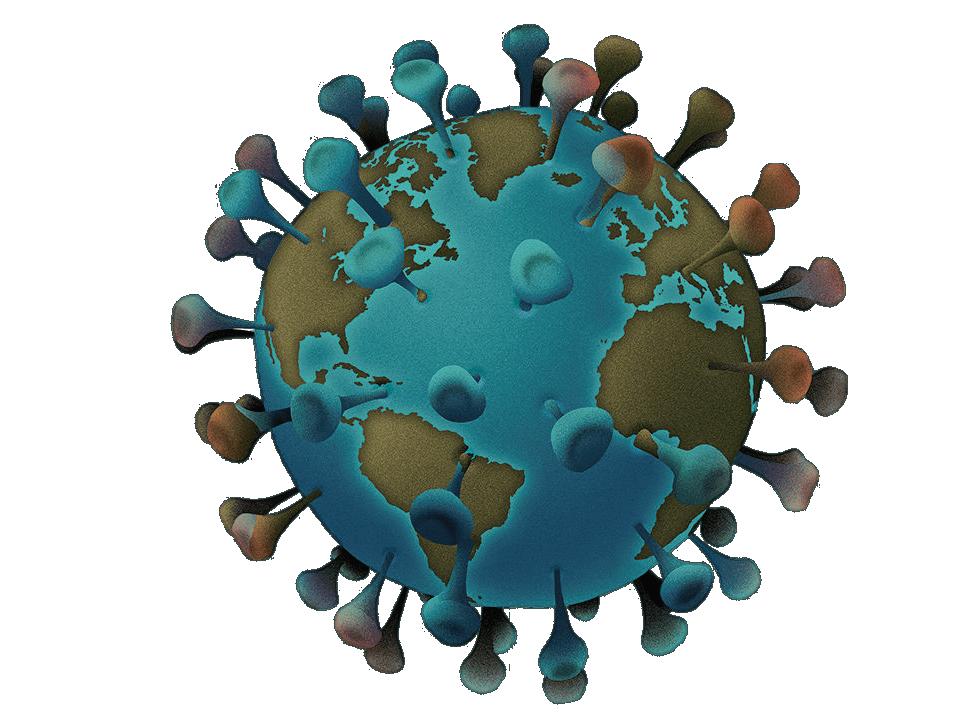
6 minute read
POST-PANDEMIC MULTILATERALISM
Has the pandemic and multiple global crises renewed the impetus for multilateralism? RESEARCH TEAM
SYNERGIA FOUNDATION
Advertisement

Billy Vincent’s song “Trouble Never Comes Alone” could well have been written to describe 2022, which saw a host of misfortunes joining forces to batter humanity. From the pandemic to climate change to rising debt to food crisis and all compounded by the war in Ukraine, and possibly the nightmare is still far from over!
These multiple crises put the spotlight on fixing the right priorities to channelize resources most effectively, mitigating the multiple shocks and socio-economic aftermath of these crises and their ongoing consequences.
Consequently, the question uppermost in mind is what are the longer-term goals which can foster a renewed cooperative world order and vigilant global governance systems to manage ongoing and future crises?
MULTILATERALISM IN REGRESSION?
The past few decades of global integration and expansion through multinational organisations have only resulted in limited success. The United Nations has proven ineffective in security crises, having compromised its core values by neglecting to address human rights abuses.
What has clearly emerged is that large multilateral organisations have become ponderous and unwieldy, incapable of taking hard decisions. In a nutshell, they appear to have outlived their usefulness unless they re-create themselves. Even a highly successful bloc like the EU, which many European nations, including Turkey, aspire to join, saw BREXIT, sowing the seeds for future dissension.
Globalisation appears to be on the back foot, with international trade assuming the mantle of regional or bilateral arrangements and alliances. Even emerging free trade areas (FTA) are confined to geographical boundaries, with outsiders being kept out.
It is estimated that since 2008, a slowdown in the global integration of trade, markets and finance point towards a period of “slowbalisation” or even “deglobalisation.” Trade conflicts between China and the U.S. and the effects of the Covid-19 Pandemic on global value chains have exposed and accelerated these shifts.
Multilateral mechanisms have largely failed, like the Doha Development Agenda of the World Trade Organization (WTO). These have revealed structural inefficiencies and the unrealistic nature of goals, which aim to control trade on a global scale and reach consensus among more than 160 states with different and sometimes irreconcilable interests. Overall, multilateral frameworks have not achieved their overambitious goals despite the continuous expansion of their bureaucratic structures.
Globalisation appears to be on the back foot, with international trade assuming the mantle of regional or bilateral arrangements and alliances. Even emerging free trade areas (FTA) are confined to geographical boundaries, with outsiders being kept out.
The African Continental Free Trade Area came into force in 2021 and became the largest trade area in the world. One year later, the Regional Comprehensive Economic Partnership (RCEP), a free trade agreement between 15 Asian-Pacific countries, came into force.
Bilateral negotiations are already giving way to more pragmatic modes of cooperation. The U.S. is no longer the lone superpower. It faces competition from China (and Russia before the latter went into Ukraine), who have expanded their influence while openly defying the principles of the international liberal order. These powers employ soft and hard power to promote alternative political and economic models.
The UN is an obvious example of the limitations and failures of multilateralism and the challenge confront ing a liberal international order. Its size is often held responsible for its inability to manage geopolitical competition and ideological struggles. While the U.S. has been lim iting its contributions to the UN since President Donald Trump’s president ship, China has rapidly increased its share and has become the sec ond-largest donor in 2019.
Several Chinese nationals or ap pointees are at the helm of UN spe cialised agencies. This, of course, has implications for the organisation’s ability to challenge Chinese ambitions and any in fringements on the core principles and goals of the UN on fundamental issues such as human rights. The conflict in Ukraine, in turn, has exposed fault lines in European security that most multilateral actors had failed to acknowledge.
As the world struggles with globalisation and conflict resolution, what is the role of international organisations and multilateral bodies? Many sweeping changes are occurring, and transformation seems inevitable for grand multilateral organisations.
Russia’s aggression in Ukraine has proved that much more effort is required to sustain liberal principles. Analysts predict that multilateralism’s future depends on two events, the outcome of the war in Ukraine and the leadership in the U.S.
HEALTH DIPLOMACY TO BOOST MULTILATERALISM?
The Pandemic created challenges for global governance but also an opportunity to strengthen the push for strong and independent international institutions.
The global health sector has become vulnerable ow- ing to the threatened availability, accessibility, affordability, and delivery of medical services. In this atmosphere of heightened risk, globalisation adds another dimension since the vulnerability of any country could create a crisis worldwide. In short, it implies that no one is safe until everyone is safe. The Pandemic could catalyse greater cooperation in the global response to medical emergencies through global health diplomacy (GHD).
Several regional and intergovernmental political forums, such as G7, G20, and the EU, have illustrated this coordinated effort during the Pandemic. This is called “club diplomacy”, where heads of state and governments’ membership are limited, with rotating presidencies like G7 and G20 Summits. These groups made several declarations acknowledging the collaborative response to the situation.
Several initiatives, such as COVAX, aim for worldwide access to the COVID vaccine, a joint initiative by GAVI Vaccine Alliance and WHO with an initial goal to provide two billion doses of vaccines worldwide in 2021. A laudable effort which ultimately collapsed in the face of ‘vaccine nationalism’, it can act as a template for the
Even before the outbreak of the Pandemic, other areas, such as- climate change, Australian bushfires, economic tradeoffs and protectionism- pushed for reforming multilateralism. COVID-19 has been the perfect opportunity to strengthen the case for multilateralism, given how individual nation-states have been completely overwhelmed and unable to respond resiliently to the gravity of the problem.
Shifting Power Poles
The 21st century has witnessed a significant change in the power balance, demonstrating that a unipolar world would no longer be viable. As power shifts East, there is bound to be a degree of resistance in the West. Ultimately, regional poles could lead to the diffusion of power equations which could deal with issues regionally vis a vis globally.
Advocates for multilateralism refer to the Pandemic as an inflexion point which underscored safeguarding the interest of the larger global community rather than narrow national interests, especially in the context of pandemics, climate change, international terrorism and cybercrimes, to name a few. The world will be at peace only if there is equitable growth and justice for all and not merely the prosperity of the privileged few.
However, the so-called ‘sovereignty trap’ overshadows the global cooperative effort. For most sovereign nation-states, health is a national responsibility, as the determinants of health are markers for national pros- perity and power.
The health sector is also a source of immense wealth as pharmaceuticals, surgical processes, and devices, developed at great cost, bring vast returns to their innovators. Few rich nations would like to sacrifice this perennial source of revenue at the altar of global governance.
Multilateralism’s transformation cannot depend solely on regional and global institutions. Analysts predict that it will require efforts by a network of devoted scientists and other groups.
Historically, philanthropic groups have taken this approach by engaging in global surveillance innovations. Examples include the Coalition for Epidemic Preparedness Innovation (CEPI) and some vaccine companies stimulating a distributed multilateral and speedy production of vaccines.
European Commission
The crisis in Ukraine has also presented an opportunity for us to come together. The EU is not an international organization. It is a grouping of states who have decided to work together – to achieve peace and have an impact on the rest of the world to smoothen geopolitical tensions and find solutions to global problems.
Oecd

We have a series of challenges – some structural and long-term while others are more immediate. What all these problems have in common is that a better coordinated global approach would help us address these issues better. Climate change is the biggest problem which brings us all together.
Unctad
The Black Sea Grain Initiative is an excellent example of how dialogue and cooperation made it possible to release grain from Ukraine even during a war. So, negotiation and international solidarity should persevere.
Assessment
The COVID 19 pandemic is just a forerunner of possible worse pandemics that humankind may have to confront, hopefully not too soon. This, along with other crises like vanishing biodiversity, climate disasters, and armed conflicts, intersects at a point to give them a global dimension. Therefore, how can these be defeated unless we adopt a global approach?
Needless to say, the guiding force of the new global agenda should be a renewed commitment to global solidarity and sustainable development. The world must organize on a whole-of-society basis nationally and collaborate internationally.
There is a need to revamp the processes that rule multilateral organisations like the World Bank. Most importantly, these organisations must shift focus from direct lending to mitigating global risks so as to generate private capital and revitalize global savings into meaningful development finance.









